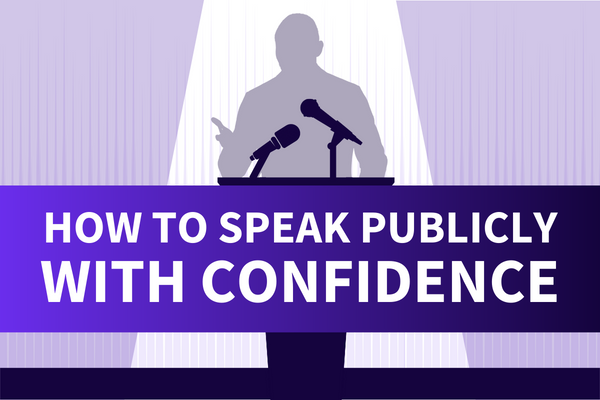Speaking publicly and in front of an audience can be a nerve-racking experience for everyone. It stands true, irrespective of the platform or forum on which an individual stands and delivers their speech. It makes sense, too: it’s hard to speak publicly with confidence with many eyes on you simultaneously, all of which appear to be judging the value of your words.
However, such a feeling is often caused by inexperience, and anyone can overcome it by following a few tips. For instance, a person can practice their speech using the Teleprompter app, allowing them to present without fear of forgetting the content of their speech. They can also record themselves practicing, practice in front of friends or colleagues, or practice anxiety reduction techniques, like breathing control.
Essentially, there are many ways to build your public speaking skills, even if you’re entirely new to the world of speaking. Let’s review a few of these other tips to speak publicly with confidence.
1. Know Your Audience
First and foremost, preparation is key, especially regarding your audience. Not only will it allow you to craft a presentation that’s relevant and interesting for the people in the room. It will also make you more confident that you understand and relate to them, boosting your speaking confidence at the same time.
To get to know your audience before your presentation, ask yourself the following questions:
- What challenges is my audience facing right now?
- What topics are they asking to learn more about?
- What changes are entering their industry?
- How do your past experiences – personal and professional – relate to theirs?
Additional ways to know your audience can be gleaned from pre-event surveys or conversations with the event organizer prior to your speech. But, no matter what route you take to learn about your audience, remember: Every aspect of the presentation should be geared toward them.
2. Use a Visual Aid
Second, if you want to speak publicly with confidence, add support mechanisms for your words. No audience can follow or retain information when they’re presented solely with words for a prolonged period of time. This makes visual aids inarguably valuable, and as the name suggests, they help you deliver the message of speech or presentation more effectively. Moreover, they make your material more memorable, in turn making the audience more likely to implement your advice.
When choosing one to use, visual aids can come in numerous forms. A visual aid can entail a video, image, graph, chart, or anything else the audience can see and perceive with their eyes. Even something as simple as highlights of the text of your speech can also help, as they draw audience attention to the relevant and essential points.
When in doubt about which visual aid to use, don’t overcomplicate it. Start with images to support your words or a slide deck to break them into easy-to-remember bullet points. You can always work in additional visual aids as you rehearse and narrow down which do and don’t work well.
3. Visualize success
Third, it sounds overly simplistic, but learning to speak publicly with confidence often starts with a facade. Most people worry about failing or messing up before speaking in front of an audience, but, in some cases, this excessive anxiety only serves to make the speaker nervous and tense.
Instead, as you prepare for a speech or presentation, keep thoughts of failure out of your mind beforehand, and imagine how amazing it would feel once you deliver your speech successfully.
Put simply, sometimes you just have to fake it until you make it. According to social psychologist Amy Cuddy, your best bet is, in fact, to put up a front even if you’re nervous. In her words, per her 2012 TED Talk, “Don’t fake it till you make it. Fake it till you become it. Do it enough until you actually become it and internalize.”
In other words, as you prepare for your next public speaking event, be positive. Even if you are nervous and shaky, do your best to pretend that you have no fear. Before you know it – and with enough practice – you truly won’t. 💪
4. Know Where to Look
Fourth, to suggest that you know how to speak with confidence, know where to look when delivering a speech. It’s a small detail, but suppose you keep staring at a single person or do not look at anyone. In both cases, the audience is going to feel left out (and probably confused, too, if you’re fixed on a single audience member).
To avoid this when speaking publicly, go over the eye line of every person in the audience, moving slightly to the left and right. Scan the audience as you speak, as if you’re trying to make eye contact with everyone at least once.
Over the course of your presentation, this will suggest you are speaking to everyone instead of a few people. It will also add to the perception that you’re a confident and capable speaker, even if in actuality you’re nervous.
5. Only Write Down the Bullet Points
The fifth way to learn to speak publicly with confidence is to simplify your notes. Most of us naturally want to read from a well-written and extensive script. However, as prepared as this makes speakers feel, it can also unintentionally make the speech feel insincere or stiff. Ultimately, this can create disconnection with the audience.
Alternatively, when you write your speech or presentation notes, jot down the crucial points or keywords. From there, expand them and improvise where needed as you deliver your content. This makes the entirety of your speech feel genuine and allows you to better maintain eye contact with the audience.
Keep in mind that this doesn’t mean you can’t memorize phrases, jokes, or other parts of your speech. It just means that, when practicing, use your bullet points only, so any memorization can still appear natural and comfortable, as if you’re saying everything for the first time.
6. Keep it Simple
Lastly, when writing a speech, many people believe that the audience wants fancy words and highly structured sentences. However, in actuality, the vast majority of audiences don’t want fluff. They want to hear your expertise, your experience, and your insights as efficiently and relatably as possible.
To accomplish this, deliver your speeches and presentations using short phrases and powerful sentences the listeners can easily follow and understand. Even an audience of highly educated people will become bored and confused if a sentence meanders in too many directions without making a point.
In addition – assuming it’s appropriate, given your topic and audience – make sure your speech isn’t too heavy. Jokes and stories, for example, can be incorporated to keep the audience interested. Furthermore, two-way speaking with inputs from both sides can help make the session engaging.
Conclusion
Long story short, if you want to look like you can speak publicly with confidence, preparation makes perfect in everything you do. If you want to make sure you connect with your audience, prepare by researching their goals and challenges and practice a simple, impactful presentation. If you want to ensure your speech is memorable, prepare by mastering its key points and adding visual aids.
Like we said at the beginning, there are many ways to build your public speaking skills, even if you’re entirely new to the world of speaking. But, if you prepare enough and follow these tips, you’ll be commanding the stage with confidence in no time.
For more information about public speaking and how a teleprompter app can streamline your presentations, check out Teleprompter’s website. Special thanks to Shazzad Hossen at Teleprompter for his insights in this guide.




